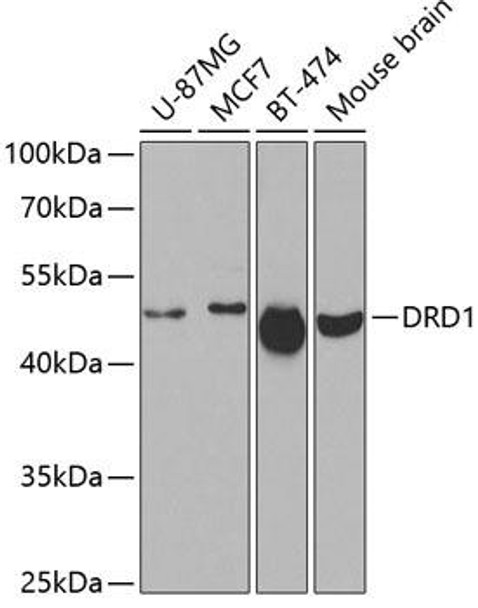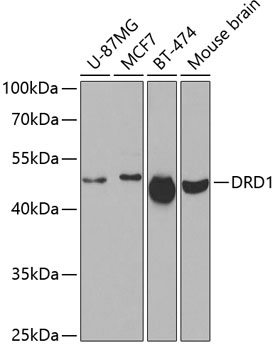Anti-DRD1 Antibody (CAB2893)
- SKU:
- CAB2893
- Product type:
- Antibody
- Reactivity:
- Human
- Mouse
- Host Species:
- Rabbit
- Isotype:
- IgG
- Research Area:
- Cell Biology
Description
| Antibody Name: | Anti-DRD1 Antibody |
| Antibody SKU: | CAB2893 |
| Antibody Size: | 20uL, 50uL, 100uL |
| Application: | WB |
| Reactivity: | Human, Mouse |
| Host Species: | Rabbit |
| Immunogen: | A synthetic peptide of human DRD1 |
| Application: | WB |
| Recommended Dilution: | WB 1:500 - 1:2000 |
| Reactivity: | Human, Mouse |
| Positive Samples: | U-87MG, MCF7, BT-474, Mouse brain |
| Immunogen: | A synthetic peptide of human DRD1 |
| Purification Method: | Affinity purification |
| Storage Buffer: | Store at -20°C. Avoid freeze / thaw cycles. Buffer: PBS with 0.02% sodium azide, 50% glycerol, pH7.3. |
| Isotype: | IgG |
| Sequence: | Email for sequence |
| Gene ID: | 1812 |
| Uniprot: | P21728 |
| Cellular Location: | Cell membrane, Endoplasmic reticulum membrane, Multi-pass membrane protein |
| Calculated MW: | 49kDa |
| Observed MW: | 49kDa |
| Synonyms: | DRD1, DADR, DRD1A |
| Background: | This gene encodes the D1 subtype of the dopamine receptor. The D1 subtype is the most abundant dopamine receptor in the central nervous system. This G-protein coupled receptor stimulates adenylyl cyclase and activates cyclic AMP-dependent protein kinases. D1 receptors regulate neuronal growth and development, mediate some behavioral responses, and modulate dopamine receptor D2-mediated events. Alternate transcription initiation sites result in two transcript variants of this gene. |
| UniProt Protein Function: | DRD1: a G-protein coupled receptor.One of the five types (D1 to D5) of receptors for dopamine. The most abundant dopamine receptor in the central nervous system. The activity of this receptor is mediated by G proteins which activate adenylyl cyclase. Interacts with calcyon. |
| UniProt Protein Details: | Protein type:Receptor, GPCR; Membrane protein, multi-pass; GPCR, family 1; Membrane protein, integral Chromosomal Location of Human Ortholog: 5q35.1 Cellular Component: endoplasmic reticulum membrane; integral to plasma membrane; plasma membrane; nucleus Molecular Function:protein binding; dopamine receptor activity; dopamine binding; dopamine D1 receptor-like receptor activity Biological Process: synaptic transmission, dopaminergic; peristalsis; elevation of cytosolic calcium ion concentration during G-protein signaling, coupled to IP3 second messenger (phospholipase C activating); behavioral fear response; prepulse inhibition; positive regulation of potassium ion transport; generation of action potential; thermoregulation; G-protein signaling, adenylate cyclase activating pathway; vasodilation; positive regulation of synaptic transmission, glutamatergic; adult walking behavior; dopamine metabolic process; synaptogenesis; behavioral response to cocaine; protein import into nucleus; conditioned taste aversion; positive regulation of cAMP biosynthetic process; visual learning; dopamine receptor, adenylate cyclase activating pathway; grooming behavior; response to drug; dopamine transport; dentate gyrus development; cerebral cortex GABAergic interneuron migration; striatum development; maternal behavior; response to amphetamine; adenylate cyclase activation; regulation of dopamine metabolic process; mating behavior; regulation of dopamine uptake; transmission of nerve impulse; astrocyte development; memory; G-protein signaling, coupled to cyclic nucleotide second messenger; habituation; glucose import; operant conditioning; sensitization; positive regulation of release of sequestered calcium ion into cytosol; dopamine receptor, phospholipase C activating pathway; positive regulation of cell migration |
| NCBI Summary: | This gene encodes the D1 subtype of the dopamine receptor. The D1 subtype is the most abundant dopamine receptor in the central nervous system. This G-protein coupled receptor stimulates adenylyl cyclase and activates cyclic AMP-dependent protein kinases. D1 receptors regulate neuronal growth and development, mediate some behavioral responses, and modulate dopamine receptor D2-mediated events. Alternate transcription initiation sites result in two transcript variants of this gene. [provided by RefSeq, Jul 2008] |
| UniProt Code: | P21728 |
| NCBI GenInfo Identifier: | 118228 |
| NCBI Gene ID: | 1812 |
| NCBI Accession: | P21728.1 |
| UniProt Secondary Accession: | P21728,Q61616, P18901, |
| UniProt Related Accession: | P21728 |
| Molecular Weight: | 75kDa |
| NCBI Full Name: | D(1A) dopamine receptor |
| NCBI Synonym Full Names: | dopamine receptor D1 |
| NCBI Official Symbol: | DRD1 |
| NCBI Official Synonym Symbols: | DADR; DRD1A |
| NCBI Protein Information: | D(1A) dopamine receptor |
| UniProt Protein Name: | D(1A) dopamine receptor |
| UniProt Synonym Protein Names: | Dopamine D1 receptor |
| Protein Family: | D(1A) dopamine receptor |
| UniProt Gene Name: | DRD1 |
| UniProt Entry Name: | DRD1_HUMAN |





